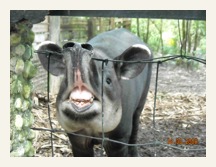Below are some sample itineraries for exploring the Northern Yucatan Peninsula of Mexico.
For a look at our latest unique tour in the Yucatan, please click here for our Yucatan Mexico Food Tour.
While we want to introduce you to the wonderful highlights of the Yucatan Peninsula, we also want to allow you to experience many of the small wonders to be found there - at small archaeology sites, traditional Mayan towns and villages, beautiful nature areas, local restaurants and markets, and with interactions with local residents. This is achieved by traveling with expert local guides and thoughtful itineraries.
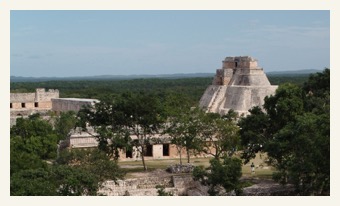
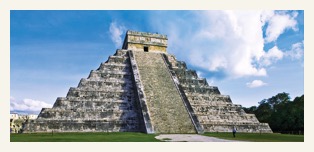
Upon being there, you will soon see why so many people from around the world have relocated to the Yucatan - warm climate, friendly residents, low crime rates, affordability, good infrastructure, beautiful scenery and sights, and of course - the fresh foods and cuisine.
Yucatan Getaway
7 days itinerary starting and ending in Merida
** An economical tour package ranging from $700 to $800 /pp/dbl **
An affordable vacation in the Yucatan (for two or more participants), featuring:
- Six overnights in colonial Merida.
- Celestún Biosphere, a 146,000 acre Reserve with a combination of coastal scrub, estuary, and mangrove, which together provides an excellent habitat for a diversity of wildlife of many sorts - best known for its Flamingos, but is also host to over 300 other species of birds.
- A private Cooking Class to explore the "Taste of Yucatan"
- Uxmal & Kabah Mayan ruins tour
- Chichén Itzá Mayan ruins tour
- Cuzamá Cenotes tour
- Free day in Merida, with option for Mayan Biking tour
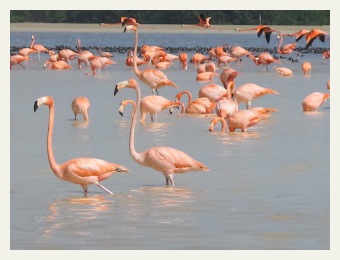
Included
- All local taxes
- Breakfast
- Meals as indicated in the itinerary
- Professional bilingual tour guide
- Transfers Airport-Hotel-Airport
- Transportation as indicated
- Truck ride at Cuzama cenotes
- Accommodation at the Hotel Caribe in downtown Merida
Not Included
- Beverages
- Items of personal nature
- Meals not specified in the itinerary
- Excess baggage charges (one piece of luggage per person and a carry-on)
- Passports and visas
- Personal expenses
- The air fare
- Tips to the guide and driver
- Travel Insurance
Day 1: Arrive at MID International Airport
After your flight we will pick you up at the Airport and go to your hotel, the Hotel Caribe. The hotel is a three stars category and has a great location located in the downtown historic area. Hotel upgrades are available.
Day 2: Celestun (B)
We start early in the morning when we pick you up at your hotel, then we will drive straight to Celestún, which is around 2 hours from Mérida. During the excursion you will go on a boat tour along the “Ria” (sea inlet) where you may see pelicans, storks, egrets, ibis and other exotic birds like the Flamingoes. After the Celestun boat tour you will stop at a fresh water spring where you'll have the opportunity to have a refreshing swim in the crystal clear water.
The Celestun tour comes to the end and we return to Mérida, the rest of the day is free for personal exploration. We recommend you to take the Turibus to get acquainted with the city and it is the perfect opportunity to see all the different restaurants and places to go at night.
Day 3: Cooking Class "Taste of Yucatán" (B/L)
We are sure you will love this tour. It is an original way to experience firsthand the flavors and traditions in the Yucatecan Cuisine. We first visit Merida’s main traditional market “Lucas de Gálvez” where we will buy the ingredients, while listening to our guide explanation of the local ingredients and traditions. Afterwards we will get a bus on our way to the local family house where we are cooking. All the menus are typical Yucatecan meals, made with family recipes. Once we have ate and chatted with our host we head back to centro. The rest of the day is free for siesta and exploration.
Day 4: Uxmal and Kabah (B/L)
The excursion will start early in the morning when your guide picks you up at your hotel in Merida. First we will visit Uxmal ruins, one of the most popular ancient mayan cities. “Uxmal” in maya means “three times built”. Here the guide will explain in depth the Puuc architect style of buildings such as the Nun's Quadrangle, the Ball court, the Turtle House and the Governor Palace.
After Uxmal, you will explore the archeological site of Kabah, Mayan name wich means “lord of a strong hand”. Kabah is linked to Uxmal by a “sacbeh" or white road used for ceremonial purpouses. Kabah is one of the stops of the Puuc Route and here you can find many structures with carved masks of the God Chaac, the important god of rain for the Mayans.
Your last stop before you return to Merida will be a restaurant for a delicious Yucatecan meal.
Note: If you want to change Uxmal and Kabah for Chichen Itza it is possible.
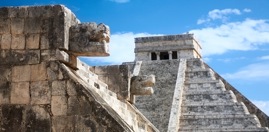
The Chichen Itza tour starts at your hotel at 9:00 am when we pick you up and drive to the site. Your guide will explain in depth about the beautiful architecture and the knowledge of the cosmos that the Mayan people had. We will learn about the "Sac beh" or white path that takes you to the Sacred Cenote where it is believed that the mayans offered sacrifices to Chaac, the god of wáter. After visiting Chichen Itza you will be taken to a restaurant to enjoy a buffet type lunch. Sometimes there are shows inside the restaurants to increase your enjoyment. These shows include the traditional dance called “Jarana”.
Day 5: Cuzama (B/L)
On this Cuzama cenote tour from Merida you will have the opportunity to be on a jewel of nature hidden in the jungle, one of those places that mostly only locals know about. You will climb on a cart pulled by a horse over railroad tracks that take you to each of the beautiful cenotes. The main cenotes in Cuzama are Chelentún (lying rock), Chansinic'Ché (ant tree) and Bolón-Chohol (bat hole). Each cenote has its own attractive, making each one of them a different adventure that you can enjoy all in a day trip. Once there, you can swim in the crystal water, dive, hang from the roots of the trees that hang on the roof of the cenote, explore the underwater world of this magnificent cave.
Then enjoy a delicious traditional Yucatecan lunch before we head back to Mérida.
Day 6: Free day (B)
This is a free day for you to relax, personal explorations, or you may arrange an option day tour.
If you are craving for something different to do, how about having an amazing Mayan experience and visit to a not so touristy place? A Mayan Biking Adventure is a wonderful day tour. First we will take you to Tixcocob a little Mayan town outside Merida, where we will have a quick visit to the market. Then bike 6.8 miles to the archeological site of Aké, a tiny site with lots of history. Afterwards we will visit the San Lorenzo de Aké Hacienda, where the henequen rope is still produced. We will return to Tixcocob riding again and enjoy a truly Mayan family lunch (included in tour) with our Mayan host. After all that you will still have half a day free!
Day 7: Adios Mexico!
This is a free day. The transfer to the Merida airport is included.
Yucatan Explorer
8 Days, starting and ending in Merida
Spending most of the nights in the Colonial city of Merida, you'll have the opportunity to visit Uxmal, swim in Xel-Ha water park, go caving at Calcehtok and at the underground rivers of the Yucatan, learn about the pink Flamingo in Celestun National Park and visit Chichen Itza, one of the New Wonders of the world.
Included
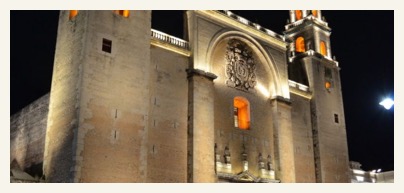
- 7 hotel nights, double occupancy
- A bilingual tour guide throughout
- All entrance fees
- Bellboys and maids
- Comprehensive walking tours
- Transfers Airport-Hotel-Airport
- Transportation in Van or private motorcoach for all scheduled activities
Not Included
- Items of personal nature
- Meals & Beverages
- Passports and visas
- The air fare
- Tips to the guide and driver
- Travel Insurance
Accommodations
- Merida: Caribe
- Valladolid: Meson del Marques
- Playa del Carmen: Las Golondrinas
Day 1: Arrive Merida Welcome to Mexico! Upon arrival in Merida we are met by tour Tour Director and then transferred to our hotel.
Day 2: Cuzama Cenotes
We visit two marvelous Cenotes located in the small village of Cuzama. The cenotes are sinkholes where underground rivers break through the limestone crust of the earth. For Mayas, they represent the doorway to the spiritual underworld. We'll get on horse-drawn trucks which take us 6 miles into the jungle to visit and swim in the beautiful, clear cenotes. We return to Merida in the afternoon.
Day 3: Celestun National Park / Merida
Celestun is home of the biggest settlement of the Pink Flamingo in the continent. To visit them, we take a boat tour and will learn about the importance of mangroves in the region. In the afternoon we will have a walking tour of El Centro of Merida to visit the Cathedral, the Casa de Montejo and the beautiful Plaza Grande. At night we watch the traditional dance of the Yucatan, the Jarana, at the spectacle La Vaqueria.
Day 4: Uxmal / Calcehtok Caves
We leave very early to go to the Mayan archaeological site of Uxmal, the three times built city. At Uxmal we will visit the 115 feet high Pyramid of the Magician and the impressive Governor's house, a wonder of the ancient world for its precision and architectonic beauty. Then we will head off to the marvelous caves of Calcehtok, the largest cave system of the Yucatan. We return to the hotel in the afternoon.
Day 5: Tixcocob Mayan Town / Coba
We will head off to the little town of Tixcocob. We'll learn about the art of making hammocks and will experience Mayan living first hand. After that, we head off to Coba which is among the largest of Mayan sites and offers the chance to explore unrestored antiquities set deep in tropical jungle. We'll overnight in Playa del Carmen.
Day 6: Tulum / Xel-ha
Today is our Caribbean experience at Tulum and Xel-Ha. Many buildings can be explored at Tulum as well as the beauty of the rugged coast. Then, we will spend the whole day in the fantastic water theme park of Xel-Ha . We leave the park in the afternoon and will spend the night at Valladolid.
Day 7: Chichen Itza
We continue our journey with a visit to the famous site of Chichen Itza. It's a big place and we'll walk a lot. This important center combines majesty and nature. A step-on guide will explain the splendid Castle, an imposing example of the immense depth of the Mayas' knowledge of the cosmos, math, and science. We will visit the biggest ball game court of the Mayan world. We'll have enough time to buy some handcrafts. If time allows, we will swim in the beautiful Ik Kil cenote. We return to Merida in the afternoon. At night, we have our farewell dinner at a Mexican restaurant.
Day 8: Return Home
We return home very early in the morning. Adios MEXICO!![]()
![]()
Mundo Maya, Northern Yucatan Exploration (group tour)
14 Days, starting and ending in Cancun
DAY 1:
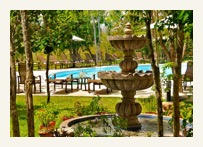
DAY 2:
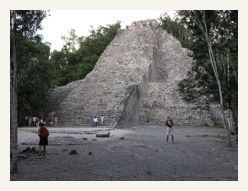
At breakfast, we have group introductions and orientation session before departing. Afterwards, we drive into the interior of the Yucatan Peninsula to tour the major archaeological site of Cobá. The ruins are set amidst a tropical jungle, making it excellent for wildlife viewing. Only a small portion of this mega site has been cleared. Most of its estimated 6,500 structures remain uncovered, but the ones that have been are graceful and impressive. The restored structures groupings are connected by shady, well maintained trails under the jungle canopy. You may hear or see monkeys, a variety of birds, and forest wildlife. (There are bicycles and "taxi" bicycles available or rent for those who want an alternative to walking the lengthy jungle paths.) Built between two lakes, with most construction occurring during the Classic Period (600-900 A.D.), it was spread over 30 square miles. Its Nohoch Mul building at 138 feet high is the tallest pyramid on the Yucatán peninsula. Coba is estimated to have had some 50,000 plus inhabitants during its apex in the Middle and Late Classic periods.
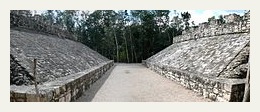
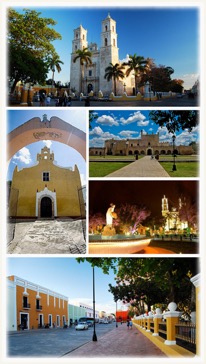
Overnights are at the lovley Ecotel Quinta Regia (www.ecotelquintaregia.com.mx). It has beautiful landscaping and is located only 5 blocks away from the Main Plaza. Its lush gardens feature a wide variety of local flora and medicinal plants. The hotel also has a nice pool for cooling off.
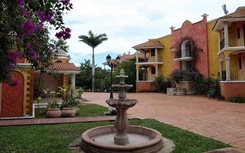
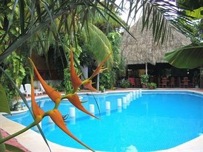
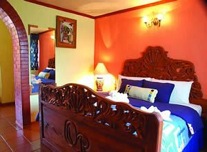
Those that would like can take an evening walk around the Main Plaza to learn of the town's history, orient for later personal explorations, and/or enjoy one the town's many fine restaurants for dinner. There are many great places in town for your independent dinners. Three excellent choices are: El Meson Marques, with courtyard dinning, located across the street on the Main Plaza (www.mesondelmarques.com); and the Taberna de los Frailes (www.tabernadelosfrailes.com), near the Main Plaza overlooking the Convent of San Bernardino de Siena which dates to 1552 and sits above the Sisha Cenote; and La Casona near the Main Plaza is worth a look around even if not dining. (B/L)
DAY 3:
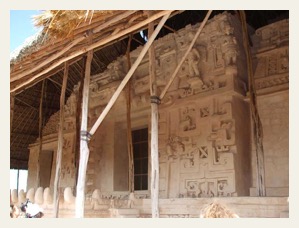
After breakfast is a tour to the partially restored site of Ek Balám. Ek Balám has one of the longest records of occupation in northern Yucatán, from about 300 BC until the Spanish Conquest. Recent excavations have uncovered some of the finest of all known Mayan sculptures. The Acropolis is the largest restored building, measuring 480 feet across, 180 feet wide and 96 feet tall. Complete with stelas, many of the buildings were built in the architectural style of Northern Petén, which included interior murals and iconography. The city's central core was enclosed with the largest defensive walls found in the Late Classic period sites. The jewel of Ek Balám's architecture is a Chenes-style, "monster-mouth" doorway atop the massive El Trono temple. The technological and artistic development shown is a sign of Ek Balam’s material and cultural wealth, manifested in the colorful and complex murals. The pictorial style of Ek Balam is considered one of the best in the Mayan area. The recent archaeological project at Ek Balam, under the direction of Leticia Vargas de la Peña and Victor R. Castillo Borges of the National Institute of Anthropology and History (INAH), has made a number of discoveries in the ballcourt area, among them a painted stucco frieze and a collection of burnt stone balls that may relate to the ballgame.
For those who like, while we are at Ek Balám ruins, you may also independently visit the Xcanche Cenote about 1.5km from the ruins (optional, with about $5 entrance fee). There are usually kids with bicycle taxis or you may walk. Swimming is allowed in the large cenote and they even have rappeling. Cenotes are magical, enigmatic and unique in the world and besides rain were once the only resource for fresh, sweet water in the local Yucatan jungle. They were the sacred places of the Mayas also because they represented the entrance to the underworld. The Yucatán Peninsula is a porous limestone shelf with no visible rivers; all the fresh water rivers are underground. Being porous, caverns and caves formed where the fresh water collects – hence the cenotes or water sinkholes. The water that gathers in these subterranean cenotes is a crystal clear turquoise color with a very pleasant temperature of 78° F. The stalactites and stalagmites that form inside the cenotes are true natural works of art. In many, holes in the ceiling allow the sunlight to filter into the cenotes, giving the scene a magical feeling. The cenotes of Yucatán are a natural treasure that should be seen by all.
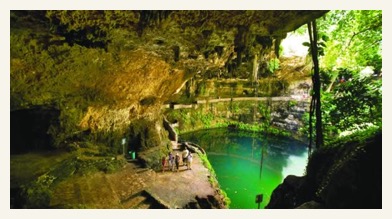
For lunch after the tour, we can stop at a local restaurant in Temozón. This little town is famous throughout the region for its ahumada (smoked meats), including longaniza (smoked sausage) which can be find in many restaurants in the region.
After a siesta at the hotel, those that would like can walk to the Zaci Cenote, which is about seven blocks from the hotel. The cool waters of the large and scenic cenote are popular and you are welcome to take a dip. About a third of the cenote is covered with stalactites and stalagmites and there is a walkway around the entire cenote. There is also restaurant located above that serves cold drinks and traditional cuisine. (B/L)
DAY 4:
Early morning tour to the famous archaeological site of Chichén Itzá to explore this incredible "Mexicanized-Maya" site. The site is overwhelming and is certainly deserving of its notoriety. The immense scale and variety of architectural styles will definitely amaze. Sitting at the edge of the Sacred Cenote and contemplating will stimulate your imagination. The site is the most excavated and famous of all the great Mayan cities. The ruins are divided into two areas. One group belongs to the classic Maya Period and was built between the 7th and 10th centuries A.D. The other group corresponds to the Maya-Toltec Period, from the later part of the 10th century to the beginning of the 13th century A.D. Containing the largest ballcourt in the Mundo Maya, the famous El Castillo, astronomical observatory, large cenotes, skull racks - it's incredible archaeology and iconography must be seen to be believed. In 2007, the El Castillo (KuKulkan Pyramid) was named one of the New Seven Wonders of the World.
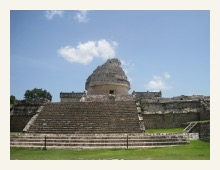
For lunch and to relax, we go to the swimmable Yokdzonot Cenote (www.yucatanmayanretreat.webs.com). About 10 minutes from the ruins, the cenote and restaurant is operated by local women starting their own ecopark. It is a good place to learn about local medicinal plants and the authentic Yucatecan meals include handmade tortillas. The cenote is far less crowded than the Ik Kil Cenote which is close to the ruins.
Afterwards, we return to Chichen Itza to view the ruins we missed in the morning visit before returning to Valladolid. The archaeological site takes up about 4 square miles and it takes most of a day to see it properly. (B/L)
DAY 5:
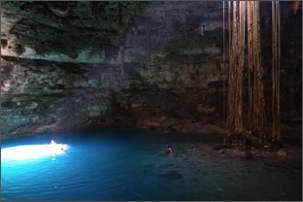
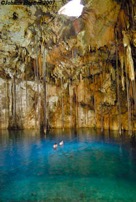
Afterwards, we depart for the Spanish Colonial city of Izamal. Depending on our "mood", we may make a quick stop at small mezcal distillery to lift our "spirits" and see how agave plants are used to make pulque, mezcal and tequila. In route to Izamal, we will stop at the pretty village of Uayma to see and learn about its colorful church. In colonial times Uayma
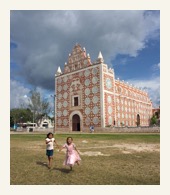
At Itzamal, we will explore the Franciscan monastery of San Antonio de Padua, whose construction started in 1533 and completed in 1561, making it one of the first monasteries in the New World. It is site of the largest atrium in the Americas and second only to the Vatican. Izamal is a jewel of a colonial city, with many the historic buildings painted yellow. Cobblestone streets and colonial lampposts complete the scenery. Clean, peaceful and quaint, this is a great town to stroll through. There are Mayan pyramids, colonial-style buildings, parks and plazas, horses and buggies, and lots of people-watching.
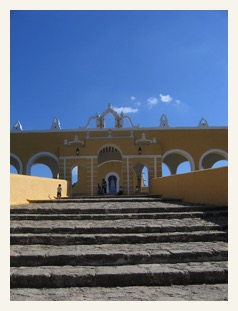
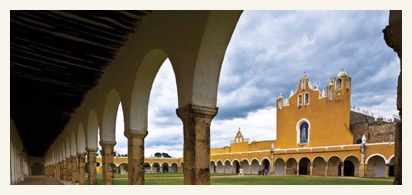
After lunch in this historic city, we continue on to Mérida for three overnights to explore this capital of the State of Yucatán and enjoy the city and its Sunday events. This vibrant Mexican city still retains much of its colonial charm. At one time, it was one of the richest cities in the world. It is often called the "white city" for its architecture and native dress, but as you will see, it is also a very "colorful" city; full of new sights, sounds and smells. Founded by the Spanish in 1542, Mérida was built over the ancient Maya city of Tiho. It was named Mérida because the Mayan city reminded the Conquistadors of the Roman ruins in Mérida, Spain. Mérida has one of the largest historic districts in the Americas (surpassed only by Mexico City and Havana). During evening strolls down peaceful streets, you can admire some of the beautiful old houses and landmarks found at every turn in downtown Merida. The historical center of Mérida is currently undergoing a renaissance as more people are moving into the old buildings and reviving their former glory. Many are now winter homes owned by foreigners as the city's popularity for a great place to live has grown internationally. Because of its tranquility and cleanliness, Mérida has also become a popular place for families from other Mexican states. Many people have moved here from Mexico City, where crime, pollution and overcrowding are evergrowing problems. Crime is not tolerated in Mérida, and it has the distinction of the city with the lowest crime rate per capita in Mexico.
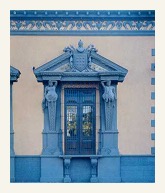
Merida also boasts a large number of restaurants for all types of cuisine, from the most basic and inexpensive to the most sophisticated fine dining. Traditional Yucatecan cookery derived from the mixing of Spanish and Maya cultures. It is the combination of recipes and ingredients from those two culinary traditions that has resulted in the characteristic flavors of Yucatecan cuisine. It also includes influences from Caribbean, European, and Middle Eastern cultures. Yucatecan food is renowned throughout Mexico for its strong condiments and the predominant use of corn. For instance, dishes like lime soup, papadzules and Motul-style eggs are all made with fried corn tortillas, and panuchos and dzotolbichay are made with corn dough. Another common ingredient in some of the most exquisite traditional Yucatecan dishes is turkey. And not to be ignored are wonderful Yucatecan desserts, most of which are prepared with locally grown fresh fruit.
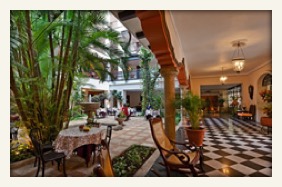
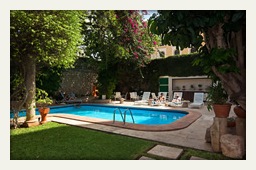
Saturday and Sunday nights are part of En El Corazón de Mérida (In the Heart of Merida), when Calles 60 & 62 are closed off to traffic around the Main Plaza from 8 pm to 2 am and the restaurants and bars put their tables and chairs in the street. This is literally an open-air fiesta as there are bands on every block and other shows. Temporary stages host everything from rock to salsa to trova singers. On Saturday nights you may also go to the outdoor Fiesta Mexicana at the beginning of the Paseo Montejo at Calle 47. Here you will find vendors, food booths and Mexican folkloric entertainment. (B/L)
DAY 6:
Sunday is a fun and colorful time in downtown Merida,
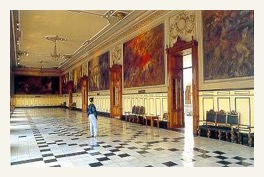
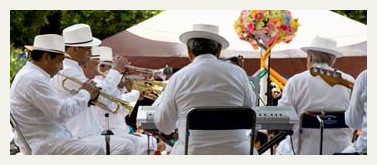
Later in the afternoon, we all meet back at the hotel around 2pm for a visit the new Gran Museo Del Mundo Maya
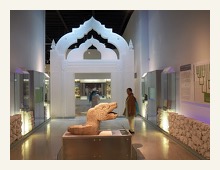
The evening is free to enjoy the Sunday outdoor concerts and activities. (B)
DAY 7:
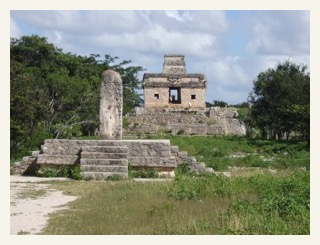
In the morning is a tour to the archaeological site of Dzibilchaltún with it's beautiful Xlacah Cenote (bring swimsuit), including a visit to the renovated Museum of the Pueblo Maya. The site's Temple of the Seven Dolls is also known as the Temple of the Sun, a square structure which was a focal point of the city. This second name may come from the phenomenon which takes place twice yearly, at the spring and fall equinoxes, when the rising sun is visible through one window and out the other, a tribute to the advanced mathematical knowledge of the Mayas. This site is distinguished due to its long history, which goes back from the mid Preclassic period to the Postclassic period. Its longevity can be explained, among other things, by its privileged location, 17 km from the coast and next to an area of fertile soils. Dzibilchaltún was a large city with a population of nearly 20,000 inhabitants. Dzibilchaltún was the center for salt trade and inhabited until the time of the Spanish Conquest. It is an area that is famous fo
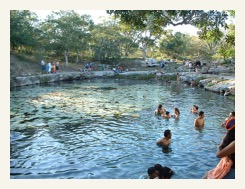
We then drive north to the coast and the port town of Progreso for lunch
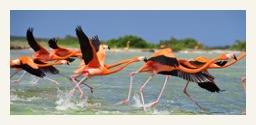
Afterwards, we continue east passing through Chicxulub Puerto, which gave name to the nearby impact point of a giant meteorite that many scientifist believe erradicated dinosaurs along with 90% of other species some 65 millions years ago. The diameter of the impact crater is some 110 miles. Along the coast we should be able to view (with luck and binoculars are handy) colorful pink flamingos
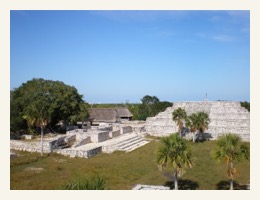
The late afternoon is free for personal for personal explorations in Merida. On Monday evening's you can enjoy an outdoor concert with traditional "Vaqueria" (Yucatecan dancing and dress) at the Palacio Municipal on the Main Plaza at 9 pm. (B/L)
DAY 8:
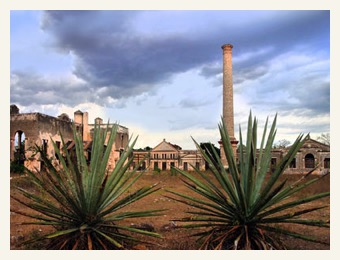
After breakfast we drive south into the Puuc region for four overnights at the lovely Hacienda Uxmal. In route we first stop at the Hacienda Yaxcopoil (www.yaxcopoil.com) to learn about sisal and henequen plantations and its import to the history of Yucatan. The hacienda is left much as it was in historic times, with furniture and machinery still in place. It was named for the nearby Mayan ruins and at one time covered about 22,000 acres of land, operating first as a cattle ranch and later as a henequen plantation. Once of of the most important haciendas in Yucatan, it has been preserved but not renovated, and now operates as a museum, and location for filming.
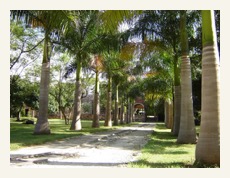
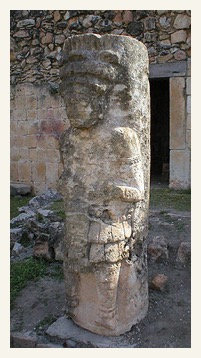
We then continue on to the Hacienda Uxmal (www.mayaland.com), located across the road from the ruins, in time for late afternoon swim in their large pool! Hand-painted tile, masonry sculptures and the generous use of the regional hardwoods sets a stately tone. The grounds are impeccably kept and lush with the flora of tropical Yucatan. The rooms are beautifully appointed and equipped with air conditioning, ceiling fans, tiled baths, free WiFI, and satellite TV. The terrace bar is an ideal spot for drinks and conversation at dusk, after a day of exploring. And, if sore, you can enjoy the spa services. (B/L)
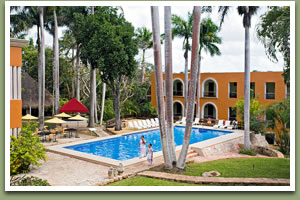
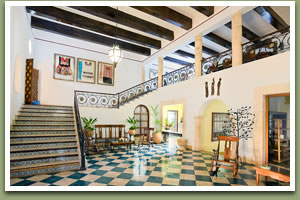
DAY 9:
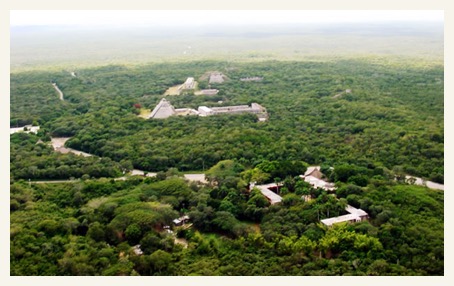
All day to tour and explore the grandiose site of Uxmal. Many consider Uxmal the most ornate and complex Mayan city yet found, you will quickly see why it is so famous as a destination. The scale of construction and the delicate carved facades are truly remarkable for any culture. Standing over 100 feet up on the Temple of the Magician, one has an excellent viewpoint of the entire site and surrounding Puuc hills. Recent excavations and restorations has brought even more of the site's grandiose structures into the light. Even before the restoration work, Uxmal was in better condition than many other Maya sites thanks to being so well constructed. Much was built with cut stones, not relying on plaster to hold the buildings together. The intricate Puuc style of Maya architecture predominates. Thanks to its good state of preservation, it is one of the few Maya cities where the visitor can get a good idea of how the entire ceremonial center looked in ancient times.
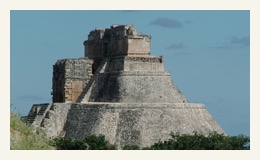
After dark, those that would like can enjoy the light and sound show at Uxmal, which is included in the day's entrance ticket. (B/L)
DAY 10:
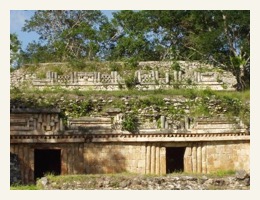
A day exploring great examples of the Puuc architectural style at the smaller archaeological sites of Kabáh, Xlapak, and Labná. The ancient Maya developed an outstanding architectural style, known as Puuc, which means “hill range” or “backbone”, after the hilly area in the southwest State of Yucatan. Vegetation in this area is low deciduous forest, animals and plants are diverse, its red soils are fertile, but there is no surface water, so the very existence of its Maya inhabitants depended on rainwater. This is why the Puuc people built numerous “chultunes” or underground cisterns which, along with natural pools, were vital to their subsistence and are still important water reserves to this day. We may have a picnic-style, boxed lunch this day as we are in remote areas. The ruins and surrounding forest also provide good birding locations.
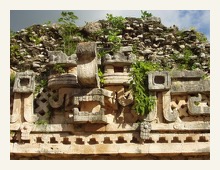
On the return we tour the impressive archaeology site of Sayil. This site is home to a beautiful palace that included 90 bedrooms for some 350 people. From the top level of the palace you can see the church at Santa Elena and across the way a tiny ruin on the side of a mountain. Like many sites in the region, there are several chultunes (under ground chambers for storing water), since the area lacks rivers. Together with Uxmal, Sayil was designated a UNESCO World Heritage Site in 1996. Sayil means place of the leaf-cutter ants in Maya and they are easily seen crossing the forest trails. (B/L)
DAY 11:
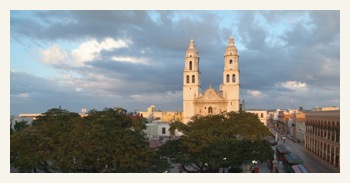
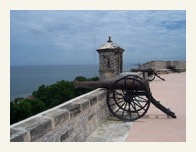
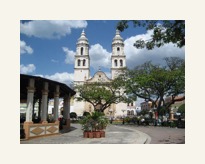
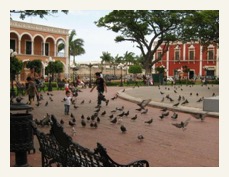
As might be expected in a coastal town, Campeche has an abundance of fresh seafood prepared in every conceivable manner including some flavored with tasty Caribbean spices. We have lunch at one of the many good seafood restaurants. Campeche is famous for its cuisine, particularly seafood and restaurants offer unique dishes such as: jamon claveteado (clove ham),
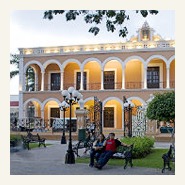
On the afternoon drive back to Uxmal. We may stop in the village of Kuck Holocj near Becal, to visit a family for a demonstration of weaving hats made from the jippi plant. These "panama" hats are woven in caves to create an environment that is humid enough for the plant fibers to remain malleable. (B/L)
DAY 12:
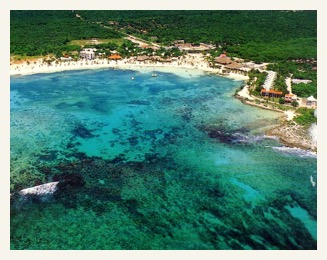
Today we take roads less traveled to the Caribbean Coast (now often referred to as the Mayan Riviera). We travel into the interior of Yucatan into the State of Quintana Roo through traditional Maya villages to the historic town of Felipe Carillo Puerto for lunch and to see the Chan Santa Cruz shrine which was important to the Maya Cruzob religious movement and independence efforts.
Before arriving at the seaside hotel, we stop for a tour at the famous Mayan seaport ruins of Tulúm. Ancient walls and the coast protected this Late Post Classic city which has become popular tourist attraction.
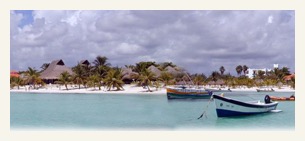
We then continue on to the small seaside town of Akumal for two overnights in the Villas Maya Bungalows of the lovely Hotel Club Akumal Caribe (www.hotelakumalcaribe.com). Akumal is one of the less commercialized areas of this Maya Riveria coastline. Local fishing boasts in the Akumal Bay add to the authentic setting. Akumal boasts beautiful white sand beaches and bright blue water set in a peaceful bay and the water is great for snorkeling and relaxing. Our bungalows are, situated among lush gardens.
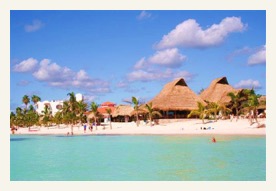
DAY 13:
This is a free day to enjoy Akamul Bay for beaching and relaxation or arrange optional day tours. (B)
Below are some of the more popular options for independent touring (most are about $100 per person):
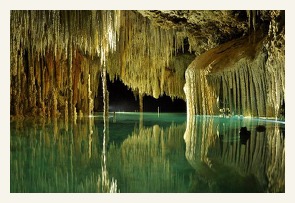
- Sian Ka'an Biosphere Reserve (www.cesiak.org, www.siankaantours.org) Travel to Muyil for a boat ride into the Reserve and Lake Chunyaxache including a chance to get out and float in the clear waters through the grass and mangrove-lined historic canals.
- Río Secreto (www.riosecreto.com). Go deep inside an underground cave, where you’ll experience true silence among some of the most dramatic mineral formations in the world. A stunning underground river with thousands of dramatic stalactites and stalagmites. You can observe natural history dating back millions of years as you hike and swim through a 600-meter route. (rio secreto video, video 2)
- Xcaret Park (www.xcaret.com)
- XelHa Park (www.xelha.com)
DAY 14:
Farewell breakfast and morning transfer to Cancun airport for flights home (recommend midday flights) out of Cancun. (B)
Service Learning Student Tour
10 Days, starting and ending in Merida
Volunteering vacations is a great opportunity to travel with a purpose, to feel good while sharing our time with kids or helping local institutions. During weekends we also have fun visiting ancient wonders and natural beauties of Mexico. Lodging is in local homes.
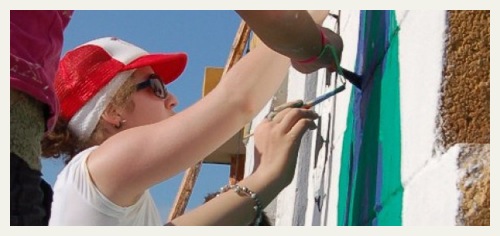
Service learning in Merida, Yucatan, is a project for student groups coming to Mexico to share their time with local kids, while doing some manual jobs and having fun.
Day 1: Arrive Merida Arrival at the International Airport of Merida on Saturday. Your Adventures Mexico guide will meet and greet you along with your host family. Transfer to your home.
Day 2: Uxmal / Calcehtok Caves The bus will wait us very early to go to the Mayan archaeological site of Uxmal, the "three times built city". At Uxmal we will visit the 115 feet height "Pyramid of the Magician", the impressive "Governor's house", a wonder of the ancient world for its precision and architectonic beauty. Then we will head off to the marvelous caves of Calcehtok, the biggest cave system of the Yucatan. We return to Merida in the afternoon.
Day 3: Hogares juveniles / Downtown Merida Our service learning activities start today as we visit a shelter home where about 20 kids live. These kids usually have one or both parents but they don't take care of the kids. Activities could include painting, gardening, cooking, playing. In the afternoon we will have a walking tour of El Centro of Merida to visit the Cathedral, the "Casa de Montejo" and the beautiful "Plaza Grande". At night we watch the traditional music and dance spectacle of La Vaqueria.
Day 4: Low income elementary school / Cuzama Cenotes Some public schools in Mexico are for students coming from families of a very low income. We will continue our service learning project spending some time with the kids and assist teachers at the class. In the afternoon we visit two marvelous Cenotes located in the small village of Cuzama. The cenotes are sinkholes where underground rivers break through the limestone crust of the earth. We will go into the jungle to visit and swim into the beautiful and clear cenotes. We head back to Merida in the afternoon.
Day 5: Hogares juveniles / Hospital This morning we go back to Hogares Juveniles. In the afternoon a visit of a public hospital is included. As some areas of the hospital are restricted, we will only be able to spend some minutes with the kids and take them some small gifts from our hometown. The rest of the day is free with our host families.
Day 6: Low income elementary school / Progreso Beach We will have a second visit to the elementary school in the morning. In the afternoon we will take the hot sun of the Yucatan at the beach of Progreso. We will sing, dance and have dinner at the beach with a traditional lunada.
Day 7: Tixkokob mayan village / Hogares juveniles We will have our off the beaten path excursion at the Mayan village of Tixcocob, where local artisans will teach us about the art of making hammocks. We will also have the opportunity to practice our Spanish at the panaderia , the tortilleria and the carniceria at a very traditional Mercado . In the afternoon we continue with our service learning project when we go back to Hogares Juveniles for our last activity there and to say good bye to our new friends.
Day 8: Celestun National Park Celestun is home of the biggest settlement of the Pink Flamingo in the continent. To visit them, we take a boat tour and will learn about the importance of mangroves in the region.
Day 9: Chichen Itza Today we visit the famous site of Chichen Itza. It's a big place and we have to walk a lot. This important centre combines majesty and nature. The splendid Castle is an imposing example of the immense depth of the Mayas' knowledge of the cosmos. We will visit the biggest Ball game court of the Mayan world. After the visit, we'll have enough time to buy some handcrafts. We go back to Merida in the afternoon to stay with our families. We'll have a farewell dinner at a Mexican restaurant.
Day 10: Departure Our service learning project comes to an end. We will have an early transfer to the airport. Adios Mexico!
Science Student Tour
10 Days, starting and ending in Cancun
Science teachers will find amazing possibilities of doing geological, biological, archaeological and agricultural educational visits with their students in the Yucatan Peninsula.
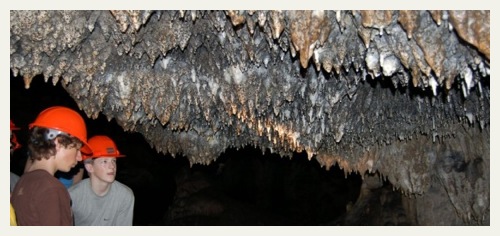
- Bat caves at Calcehtok
- Geology at Cuzama underground rivers
- Biology at Punta Laguna and Celestun
- Apiculture visiting a Mexican bee colony
- Agriculture at a Sisal plantation
- Archaeology at Chichen Itza and Uxmal
Bat caves at Calcehtok, spider monkeys at Punta Laguna, Mayan history at Chichen Itza and Uxmal; watching first hand the Mexican Melipona bee and learning about the Sisal plantations. All this combined with a visit to Xel-Ha Water Park to have fun, snorkel and relax in this Yucatan science tour.
Day 1: Arrival Arrival at the International Airport of Cancun in the afternoon. Meet with your Adventures Mexico guide and a transfer to your Merida hotel. This will usually be a full day of travel and we have many adventures tomorrow so a good night of rest is essential.
Day 2: Cuzama underground rivers Today we visit two marvellous Cenotes located in the small village of Cuzama. The cenotes are sinkholes where underground rivers break through the limestone crust of the earth. For Mayas, they represent the doorway to the spiritual underworld. After one and a half hours in our motorcoach, we get on a truck leaded by horses, which take us 5 miles into the jungle to visit and swim into the beautiful and clear cenotes. We return to the hotel in the afternoon. Night is free to wander the beautiful Paseo de Montejo Avenue.
Day 3: Celestun / Downtown Merida Celestun is home of the biggest settlement of Pink Flamingos in the continent. To visit them, we take a boat tour leaded by a knowledgeable ornithologist who will also talk about the importance of mangroves in the region. In the afternoon we will have a walking tour of El Centro of Merida to visit the Cathedral, the Casa de Montejo and the beautiful Plaza Grande. At night we watch the traditional dance of the Yucatan, the Jarana, at the spectacle La Vaqueria. We return to the hotel that evening.
Day 4: Calcektok caves / Bee Colony / Plantation We'll learn today about the Melipona, a Mexican bee with no sting. When we visit the colony, a professional apiculturist will interpret all the functions that this bee has into the ecosystem. After the bee visit, we will go to a Sisal plantation to see how this fiber is cultivated and will have a traditional lunch in a local community. After lunch we go to the marvelous caves of Calcehtok, the biggest cave system of the Yucatan. Into the caves, we'll see a vampire bat nest among the astonishing stalactites and stalagmites structures. Mr. Cuy will explain us how Mayan people used the cave as a refuge from the Spaniards during the war. We return to the hotel late afternoon.
Day 5: Chichen Itza We leave Merida very early to go to Chichen Itza. It's a big place and we have to walk a lot so dress accordingly. This important centre combines majesty and nature. A guide will explain us about the splendid Castle, an imposing example of the immense depth of the Mayas' knowledge of the cosmos. We will visit the biggest Ball game court of the Mayan world. We'll also have some time to buy souvenirs. Overnight in Merida.
Day 6: Tixcocob Mayan town / Punta Laguna We will head off to the town of Tixcocob. We'll learn about the art of making hammocks and will experience Mayan living first hand. After lunch, we head off to Punta Laguna Reserve where a naturalist guide will lead us into to jungle to watch and learn about the spider monkey and the diverse flora and fauna of the reserve. We'll have the opportunity to swim in the lagoon.We'll overnight in the small village of Tulum or Playa del Carmen.
Day 7: Tulum / Xel-ha water park Today is our Caribbean experience at Tulum and Xel-Ha. After breakfast we visit Tulum, the only known ocean front Mayan archaeological site. Then we will spend most of the day in the fantastic water park of Xel-Ha. This will be an all inclusive park, so snacks, beverages and meals will be available day long. We leave the park in the afternoon and will spend the night at Tulum or Playa del Carmen.
Day 8: Departure We return home very early in the morning. Adios MEXICO!
Below are various videos of relevance, (some are very glamorous, fanciful and surreal - however the photography is beautiful), to remind you to bring a camera :)
Mundo Maya
Quest for the Lost Maya (1 hour video by National Geographic, re northern Yucatan)
Yucatan, Yucatan 2, Yucatan 3
Campeche, Campeche 2
Quintana Roo
Chichen Itza
Uxmal, Uxmal2, Puuc sites
Ek Balam
Edzna
Coba
Merida Historic Downtown, Merida 2
Valladolid, Valladolid 2
Izamal
Maya World Museum in Merida Lightshow
Cenotes, Cenotes 2
The Mayan Calendar
Mayan Hieroglyphics
Below are a temperature chart for Cancun and a climate chart for Merida: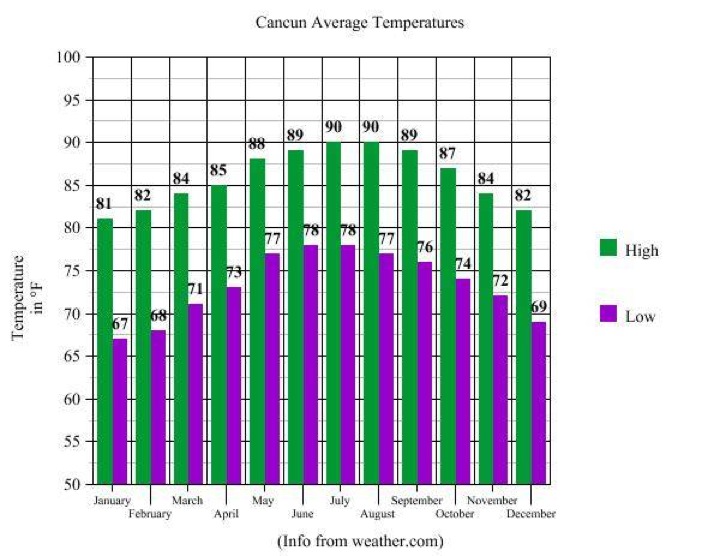
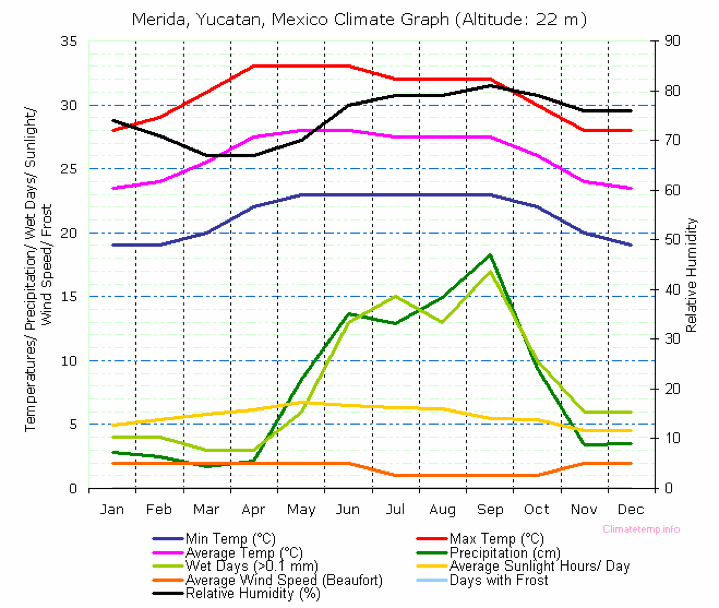
![]()
We are happy to design custom itineraries throughout the Yucatan based on your interests and time. You are welcome to call us anytime at 1-239-992-9660, or toll free at 800-446-9660, or email us at travel "at" GoExploring.com for more information.
Return to the top of this webpage :)

